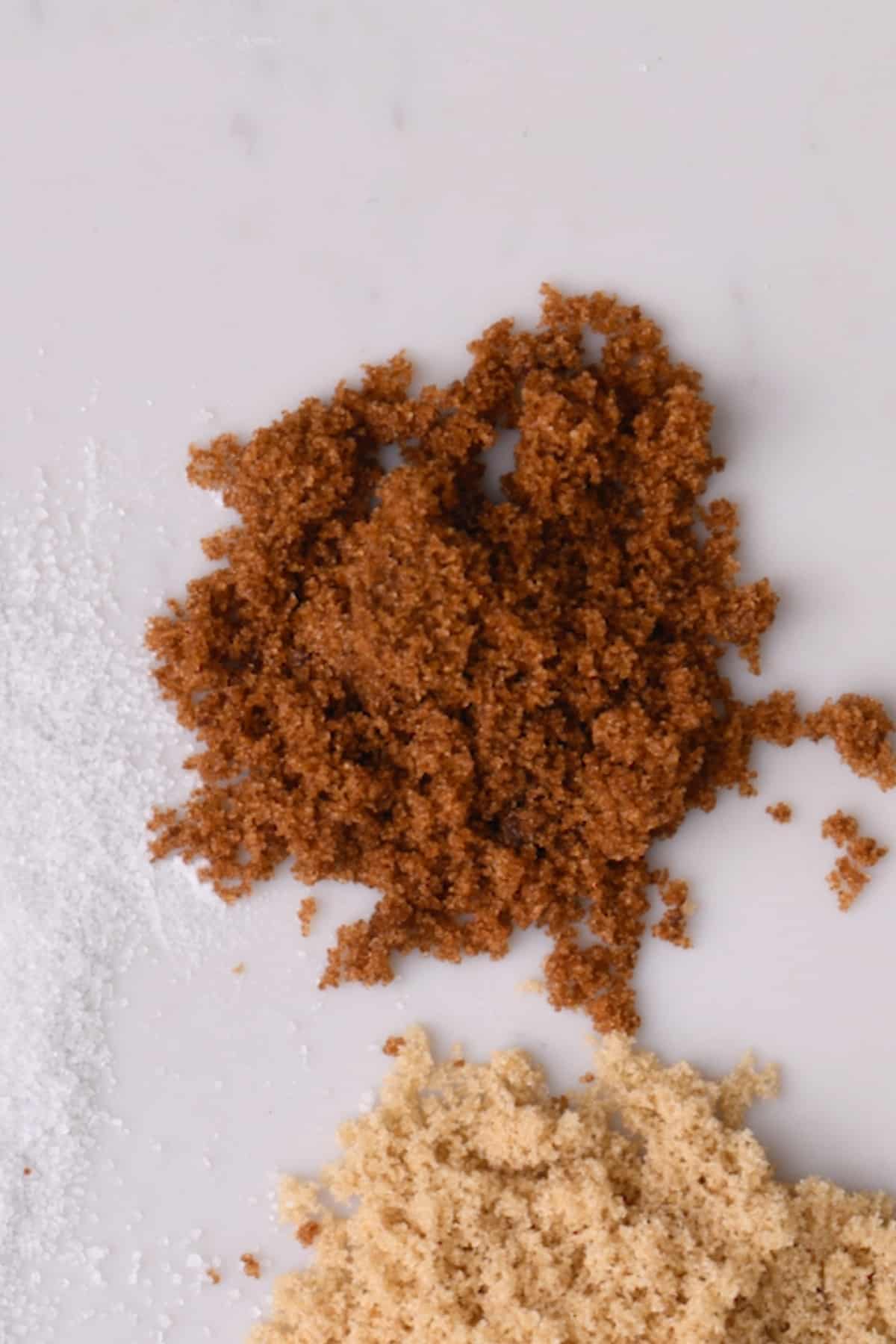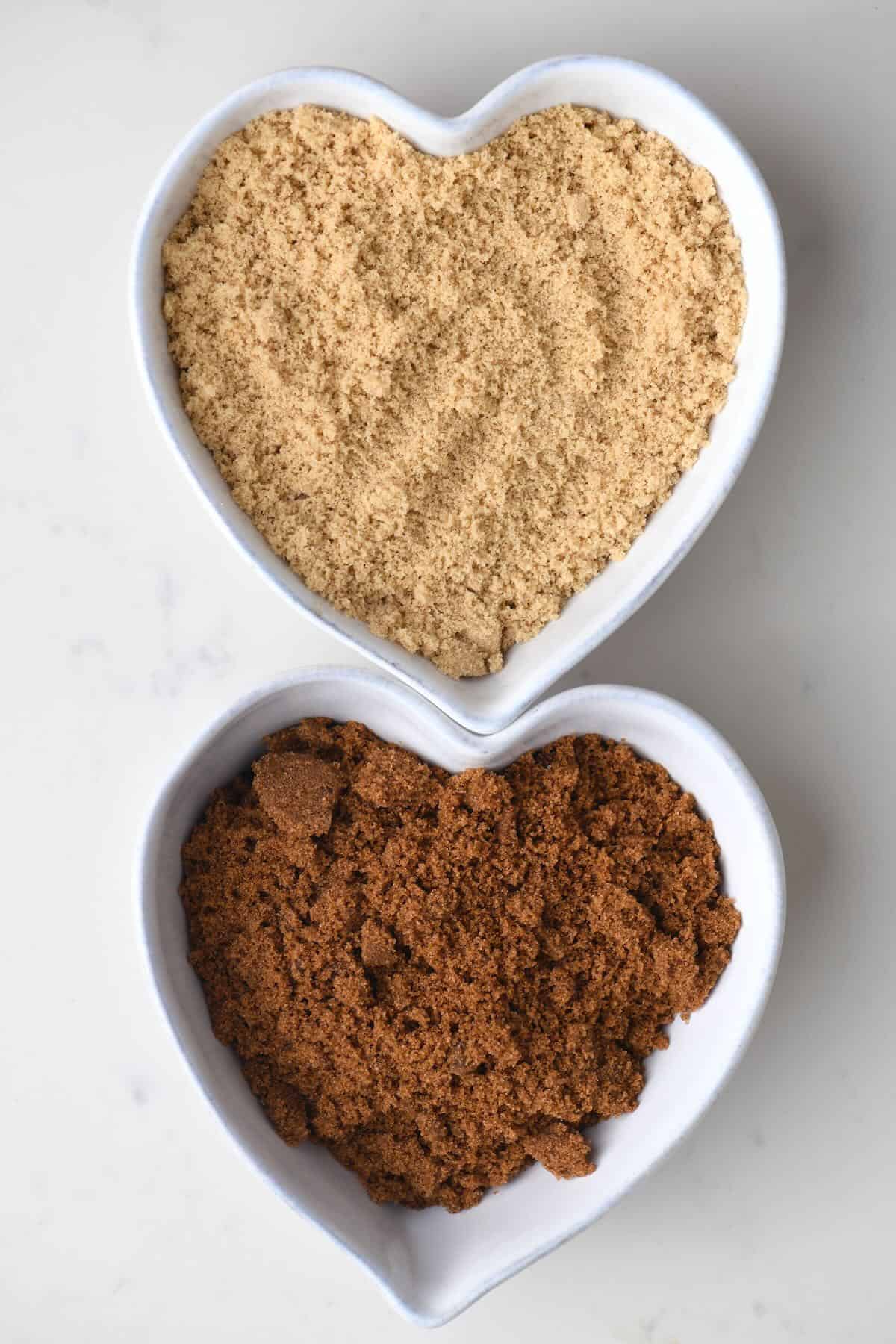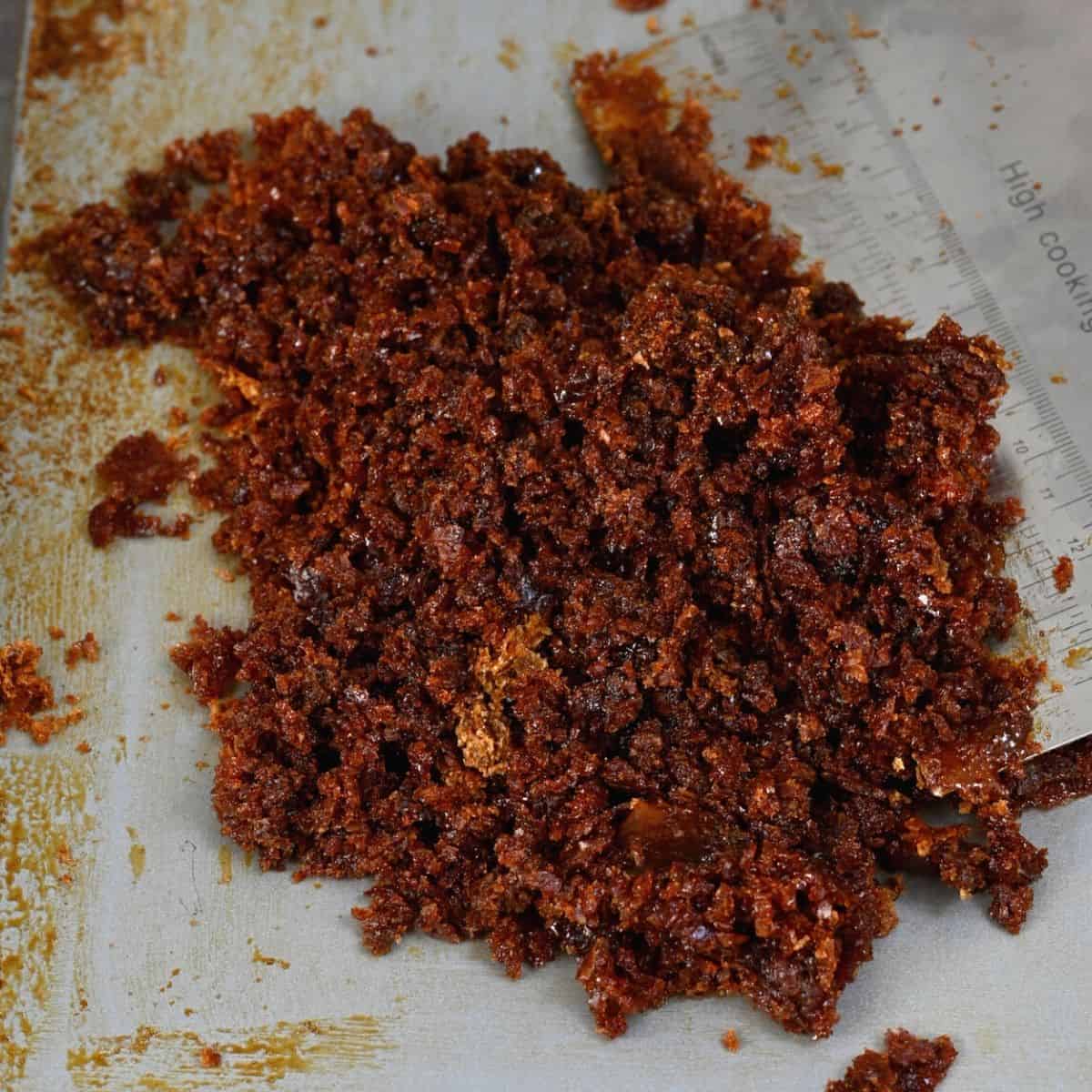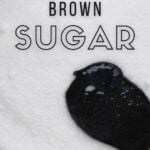This post may contain affiliate links. Please read our disclosure policy.
How to make brown sugar at home (light and dark brown sugar) with just two ingredients and in three minutes – an exact replica of store-bought versions! Plus, how to make brown sugar without molasses and other brown sugar alternatives when you don’t have molasses in your pantry!

As someone who practically lives in their kitchen, I’ve had to experiment with various “interesting” ingredient substitutions over the years. That sparked my love for making my own DIY ingredients at home (like homemade dairy-free milks, one-ingredient butter, nut/seed butters), and now learning how to make brown sugar with a combination of white sugar and molasses!
By making it at home (or using any one of the other brown sugar substitutes listed below), you never have to run out again. If you keep molasses stocked, you can even stop buying brown sugar entirely, making it at home whenever needed instead!

Want to save this recipe?
What is Brown Sugar?
To make sugar, cane juice is evaporated and spun (with several steps between). The spinning process helps to remove all the molasses from the crystals leaving behind white granulated sugar and liquid molasses. Brown sugar is then made by adding some molasses back into the white sugar in specific amounts for light vs. dark brown sugar.
What You’ll Need
This homemade brown sugar recipe requires just two ingredients:
- Granulated sugar: you need granulated white sugar.
AND
- Molasses: there are several types of molasses, though unsulphured mild or dark molasses work best over blackstrap (which has a more robust, less sweet, bitter flavor). I have also tried a version with date molasses that works, too.
To make light vs. dark brown sugar, all you need is to use a lower vs. higher molasses content.

How to make brown sugar without molasses?
There are several other ingredients you can use to make it without molasses, including maple syrup, honey, or treacle!
- Black treacle: use 1 cup of white sugar (200g) + 1-2 tablespoon (15-30ml) of black treacle.
This is the best replacement for molasses and will yield the most similar results!
- Honey: use 1 cup of white sugar (200g) + 1 tablespoon (15ml) of honey. Buckwheat honey is best in terms of color and stronger flavor.
- Maple syrup: use 1 cup of white sugar (200g) + 1 tablespoon (15ml) of pure maple syrup.
To make dark brown sugar, increase the amount used by one tablespoon. For the black treacle, you can increase it to your desired color/taste.
How to Make Brown Sugar From White Sugar?
Mixing your own DIY brown sugar is as simple as combining the granulated white sugar and molasses in a bowl with a spoon to begin and then rubbing between your fingers until very well incorporated.
It will clump up a lot, to begin with, and form little balls in the sugar. But keep working it, and it will eventually disperse evenly into a wonderful homemade sugar.

You can also use a food processor, pulsing it gently just a few times to blend the mixture rather than break up the granules OR an electric mixer on a medium speed.
For light brown sugar: use ONE tablespoon molasses per ONE cup of granulated sugar.
For dark brown sugar: use TWO tablespoons molasses per ONE cup of granulated sugar.
You can also use molasses amounts in-between or less/more than, based on personal preference.
How to make Dark Brown Sugar from Light Brown Sugar? All you need to do is add an extra tablespoon of molasses to the light sugar.
What are Other Brown Sugar Alternatives?
Along with making it at home, there are several other substitutions you could turn to in a pinch, many of which may already be in your kitchen.
1. Raw Sugar (Demerara/Turbinado)
These sugars are similar in color and flavor, though they usually contain less moisture than brown sugar and tend to have larger crystals/grains, so they don’t disperse into recipes as evenly. These are also made from cane juice (like regular brown sugar). However, they haven’t had all the molasses removed, to begin with, rather than processing it further into white sugar and then adding some of the molasses back into it.
The easiest way to combat this is to use a blender/spice grinder/mortar and pestle to break them down into a finer sugar (unless it’s being dissolved in a liquid when added to the recipe).
To use: replace the brown sugar with raw sugar in a 1:1 ratio + 1 spoonful extra liquid/fat.
2. Muscovado Sugar

Muscovado sugar is both a great alternative AND a tricky one. It’s great because it’s also a combination of sugar and molasses. Not so great because the molasses content is much higher, meaning a much wetter, often clumpier sugar that’s trickier to evenly disperse in recipes (and a more robust, complex flavor).
To use: replace the brown sugar with muscovado sugar in a 1:1 ratio.
3. Coconut Sugar
Coconut sugar has a similar look and taste, with the main difference being the moisture content. Therefore, when using coconut sugar as a brown sugar replacement, it’s a good idea to make up for that loss with the addition of extra liquid (if the recipe already calls for milk, etc.) or fat (oil/butter).
To use: replace the brown sugar with coconut sugar in a 1:1 ratio + a few spoonfuls of liquid/fat. OR use 1 cup coconut sugar + 1 Tbsp molasses (for light) or 2 Tbsp molasses (for dark).
4. Liquid Sweeteners (Maple Syrup, Agave, Honey, etc.)

Unlike coconut sugar, the issue you’ll have with this swap is too much moisture in your recipe and only works for recipes with other liquid ingredients, so you’re able to tweak the recipe. The results also won’t be as close to brown sugar as the above.
To use: per ½ cup brown sugar (100g), use 1/3 cup (160ml) of liquid sweetener – 2 Tbsp of other liquid in the recipe (like milk).
5. Jaggery (Gur)
This is last on the list because, although packed with extra nutrients, it can be trickier to work with in the same “precise” way that most baking calls for. This is because the jaggery can vary in texture and moisture content, making it harder to tweak recipes. However, it could work as a “use in a pinch” option.
To use: replace the brown sugar with finely grated/shaved jaggery in a 1:1 ratio (by weight, not cups!).

How to Use Brown sugar?
To say the options for this homemade brown sugar are plentiful would be an understatement. Some of my favorite uses include:
- In baked goods: including cakes, brownies, muffins, and for more tender, chewy cookies (like gingerbread or these ooey-gooey vegan chocolate chip cookies).
- Toffee/Caramel sauce: for a more complex flavor over regular white granulated sugar.
- Syrup: you can also use it to make a simple sugar syrup for recipes.
- BBQ sauce: light or dark – either is a perfect choice for homemade BBQ sauce.
- In ice cream: using it in ice cream will provide a caramel flavor.
- Oatmeal: to sweeten oatmeal and overnight oats.
- Dressings and glazes: will add a caramel-y/toffee-like flavor to salad dressings, glazes, and marinades for your protein of choice.
- Drink sweetener: use in coffee and hot chocolate in place of other sugars.
- Cobblers/crumbles/and crisps: sprinkle it over your fruity treat (like this mixed berry crumble or peach cobbler) for sweetness and crunch.
- Pickles: feel free to use brown sugar instead of other sweeteners when pickling foods. Like these pickled eggs, pickled red onions, pickled turnips, or pickled jalapeños.
- To balance flavors: a pinch of brown sugar added to acidic dishes/sauces like tomato-based sauces and stews (like this green bean stew) and various stir-fry sauces can help balance and add depth to the flavor.
How to Store?
Technically, brown sugar doesn’t really have a shelf life. The main issue is that it can harden over time (and when exposed to air, as the moisture evaporates). To avoid this, store it (store-bought or homemade) in an airtight container. Aim to use it within 2 years for the best quality.
You can also freeze the sugar for 3+ years. However, I recommend doing so in smaller portions (which will be easier to thaw) in fully sealed containers/Ziplock bags.
How to Make Brown Sugar Soft Again?
There are several popular methods, including:
Microwave method (wet paper towel): place it in a microwave-safe bowl and place a damp paper towel over the top. Microwave in 20-second increments, using a fork to gently break up the sugar lump between each go. Don’t over microwave, or it’ll melt.
Oven method: place the sugar in an oven-safe container at 250ºF/120ºC. Check on the sugar every 2-3 minutes, using a fork to break the sugar lump until it’s soft again (be careful as the sugar will be hot!). However, I’ve had mixed results with this method, so I usually avoid it.
Absorption method: you can do the last method using several ingredients/items but works by adding moisture to the (airtight) container of brown sugar and leaving it to slowly absorb the moisture and soften once more. You can use a slice of fresh bread, a few apple slices, a few marshmallows, or even a soaked piece of clean terracotta (30 min soak then wiped dry). This method can take a few hours to work, and you should adjust the amount of added ingredients based on how much sugar you’re trying to soften, but it’s heat-free!
Note that the various “add-ins” can affect the sugar in different ways. For example, apple slices will be harder to remove and can impart a subtle apple flavor to the sugar. Bread can cause condensation in the jar but won’t alter the flavor.
Terracotta pieces are the best option, and actually can be bought for a few £/$, work within 1-2 hours, don’t cause excess condensation/steam, and can be re-used or even added to the sugar to stop it hardening in the first place!

FAQs
This will happen when it isn’t stored in an airtight container. The moisture will evaporate when exposed to air, and the sugar hardens into a dense mass of sugar rather than softer granules.
Raw sugar simply contains residue of molasses, where it hasn’t been entirely spun out the sugar (so it is less refined). Whereas brown sugar is fully processed raw sugar with the molasses added back into the sugar. Raw sugar is usually less moist and has larger crystals.
Brown sugar has a caramel-like, almost toffee flavor. Light brown sugar is milder, whereas dark brown sugar has a deeper, more robust molasses flavor,
Yes, it’s possible to mix a combination of 50/50 erythritol and allulose (other sweeteners could be used, though I haven’t tried) with the correct amount of molasses for a simple sugar-free brown sugar substitute. i.e., ½ cup allulose, ½ cup erythritol + 1 or 2 Tbsp molasses.
If you only have coconut sugar or raw sugar to hand (like demerara) that already have a similar flavor to brown sugar, you can still make homemade brown sugar with it, ending up with an increased depth of flavor.
Related DIYs



- How To Make Powdered Sugar (Confectioners Sugar)
- How to Make Simple Syrup (with your sugar of choice)
- How to Make Unrefined Cane Sugar & Jaggery (Gur)
- How To Make Chocolate From Cocoa Beans (Bean to Bar Chocolate)
- An Introduction to Sugar and Sugar Substitutes
- The Perfect Homemade Pancake Mix
If you try this method for how to make brown sugar at home, I’d love to hear your thoughts/questions below. Also, I’d appreciate a recipe card rating below, and tag me in your recipe recreations on Instagram @Alphafoodie!

How to Make Brown Sugar at Home? (Light & Dark Brown)
Ingredients
- 1 cup granulated white sugar
- 1 Tbsp unsulphured molasses 1/2 -1 Tbsp for light OR 2 Tbsp for dark. Use light or dark molasses but not blackstrap. **
Instructions
- Mixing your own DIY brown sugar is as simple as combining the granulated white sugar and molasses in a bowl with a spoon to begin and then rubbing between your fingers until very well incorporated.It will clump up a lot, to begin with, and form little balls in the sugar. But keep working it, and it will eventually disperse evenly into a wonderful homemade brown sugar.You can also use a food processor, pulsing it gently just a few times to blend the mixture rather than break up the granules OR an electric mixer on a medium speed.How to make Dark Brown Sugar from Light Brown Sugar? All you need to do is add an extra tablespoon of molasses to the light sugar.
Notes
You can also freeze the sugar for 3+ years. However, I recommend doing so in smaller portions (which will be easier to thaw) in fully sealed containers/Ziplock bags. Check the blog post for brown sugar alternatives, tips for making the sugar soft again, and answers to top FAQs!
Nutrition
Nutrition information is automatically calculated, so should only be used as an approximation.















